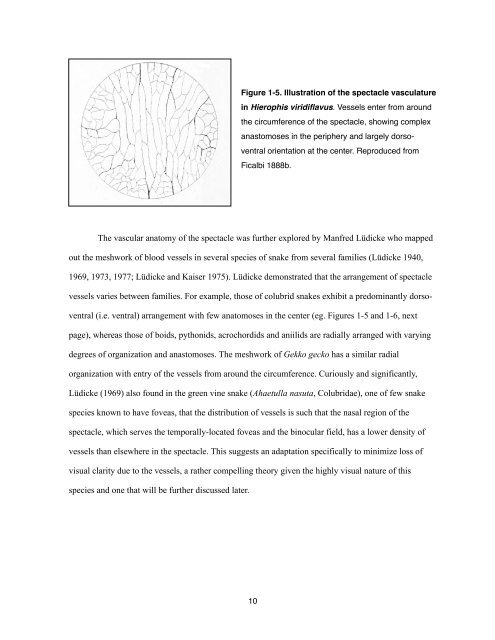Chapter 1, The Reptilian Spectacle - UWSpace - University of ...
Chapter 1, The Reptilian Spectacle - UWSpace - University of ...
Chapter 1, The Reptilian Spectacle - UWSpace - University of ...
Create successful ePaper yourself
Turn your PDF publications into a flip-book with our unique Google optimized e-Paper software.
Figure 1-5. Illustration <strong>of</strong> the spectacle vasculature<br />
in Hierophis viridiflavus. Vessels enter from around<br />
the circumference <strong>of</strong> the spectacle, showing complex<br />
anastomoses in the periphery and largely dorso-<br />
ventral orientation at the center. Reproduced from<br />
Ficalbi 1888b.<br />
<strong>The</strong> vascular anatomy <strong>of</strong> the spectacle was further explored by Manfred Lüdicke who mapped<br />
out the meshwork <strong>of</strong> blood vessels in several species <strong>of</strong> snake from several families (Lüdicke 1940,<br />
1969, 1973, 1977; Lüdicke and Kaiser 1975). Lüdicke demonstrated that the arrangement <strong>of</strong> spectacle<br />
vessels varies between families. For example, those <strong>of</strong> colubrid snakes exhibit a predominantly dorso-<br />
ventral (i.e. ventral) arrangement with few anatomoses in the center (eg. Figures 1-5 and 1-6, next<br />
page), whereas those <strong>of</strong> boids, pythonids, acrochordids and aniilids are radially arranged with varying<br />
degrees <strong>of</strong> organization and anastomoses. <strong>The</strong> meshwork <strong>of</strong> Gekko gecko has a similar radial<br />
organization with entry <strong>of</strong> the vessels from around the circumference. Curiously and significantly,<br />
Lüdicke (1969) also found in the green vine snake (Ahaetulla nasuta, Colubridae), one <strong>of</strong> few snake<br />
species known to have foveas, that the distribution <strong>of</strong> vessels is such that the nasal region <strong>of</strong> the<br />
spectacle, which serves the temporally-located foveas and the binocular field, has a lower density <strong>of</strong><br />
vessels than elsewhere in the spectacle. This suggests an adaptation specifically to minimize loss <strong>of</strong><br />
visual clarity due to the vessels, a rather compelling theory given the highly visual nature <strong>of</strong> this<br />
species and one that will be further discussed later.<br />
10
















